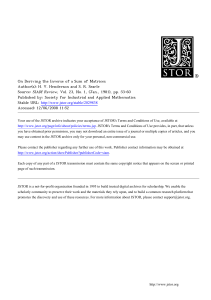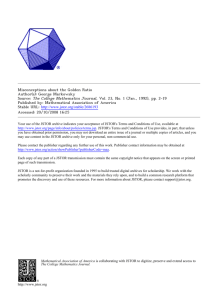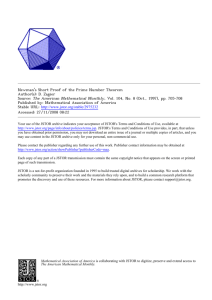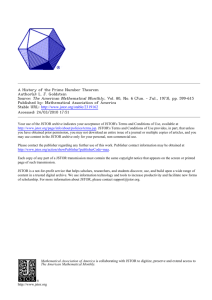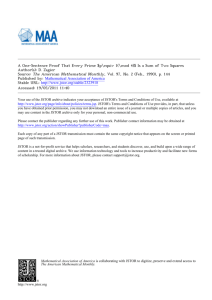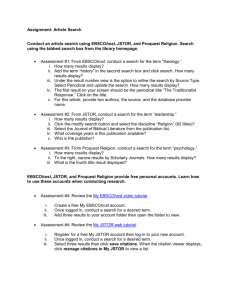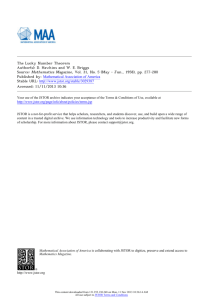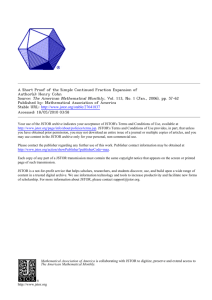Irrationality of The Square Root of Two -
advertisement
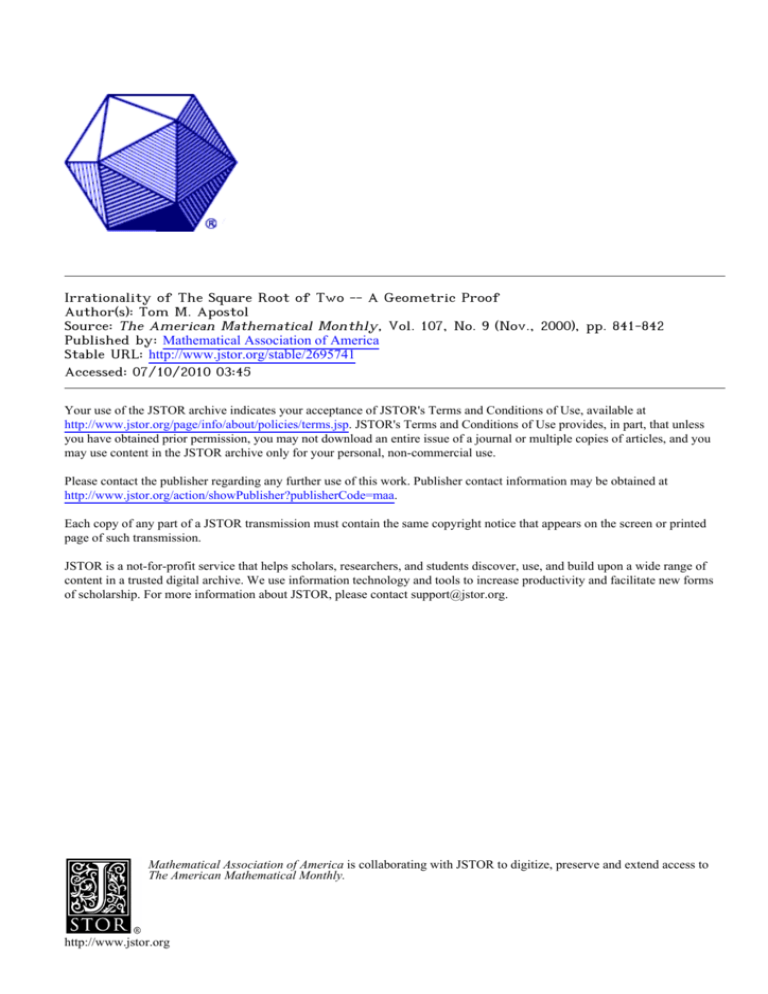
Irrationality of The Square Root of Two -- A Geometric Proof Author(s): Tom M. Apostol Source: The American Mathematical Monthly, Vol. 107, No. 9 (Nov., 2000), pp. 841-842 Published by: Mathematical Association of America Stable URL: http://www.jstor.org/stable/2695741 Accessed: 07/10/2010 03:45 Your use of the JSTOR archive indicates your acceptance of JSTOR's Terms and Conditions of Use, available at http://www.jstor.org/page/info/about/policies/terms.jsp. JSTOR's Terms and Conditions of Use provides, in part, that unless you have obtained prior permission, you may not download an entire issue of a journal or multiple copies of articles, and you may use content in the JSTOR archive only for your personal, non-commercial use. Please contact the publisher regarding any further use of this work. Publisher contact information may be obtained at http://www.jstor.org/action/showPublisher?publisherCode=maa. Each copy of any part of a JSTOR transmission must contain the same copyright notice that appears on the screen or printed page of such transmission. JSTOR is a not-for-profit service that helps scholars, researchers, and students discover, use, and build upon a wide range of content in a trusted digital archive. We use information technology and tools to increase productivity and facilitate new forms of scholarship. For more information about JSTOR, please contact support@jstor.org. Mathematical Association of America is collaborating with JSTOR to digitize, preserve and extend access to The American Mathematical Monthly. http://www.jstor.org MichaelVrahatissuggestedthis problemafter a talk on locatingclustersof ACKNOWLEDGMENTS. zeros of analytic functions that the first author gave at the Department of Mathematicsof the Universityof Patras,Patras,Greece. The authorsthankJean-PaulCardinaland BernardMourrainfor stimulatingdiscussions,and the referee for suggestingthe open problemmentionedin Section 4. Katholieke UniversiteitLeuven, Departmentof Computer Science, Celestijnenlaan200 A, B-3001 Heverlee, Belgium peter.kravanja@na-net.ornl.gov ann.haegemans@cs. kuleuven.ac.be Irrationality of The Square Root of Two -A Geometric Proof Tom M. Apostol This note presents a remarkablysimple proof of the irrationalityof 11 that is a variationof the classicalGreek geometricproof. By the Pythagoreantheorem, an isosceles right triangle of edge-length 1 has hypotenuseof length x/I. If 11 is rational,some positive integer multiple of this triangle must have three sides with integer lengths, and hence there must be a smallest isosceles right trianglewith this property.But inside any isosceles right trianglewhose three sides have integer lengths we can alwaysconstructa smaller one with the same property,as shownbelow. Therefore 11 cannot be rational. then there is a smallerone with the same property. If this is an isosceles righttriangle with integersides, Figure1 Construction.A circulararc with center at the uppermostvertex and radiusequal to the verticalleg of the triangleintersectsthe hypotenuseat a point, fromwhich a perpendicularto the hypotenuseis drawnto the horizontalleg. Each line segment in the diagramhas integer length, and the three segmentswith double tick marks have equal lengths. (Two of them are tangentsto the circle from the same point.) Therefore the smaller isosceles right triangle with hypotenuse on the horizontal base also has integer sides. November2000] NOTES 841 The reader can verify that similar arguments establish the irrationalityof vn2 + 1 and n2 - 1 for any integer n > 1. For +n2 1 use a right triangle with legs of lengths 1 and n. For /n2 - 1 use a right triangle with hypotenuse n and one leg of length 1. ProjectMATHEMATICS!,1-70 Caltech, Pasadena, CA 91125 apostol@caltech.edu Fundamental Theorem of Algebra-Yet Another Proof Anindya Sen Theorem. The Fundamental Theorem of Algebra. Let P(z) = aoz + alz 1+ -- +akZn-k + + be a polynomial of degreen ? 1 with complex numbers ai as coefficients. Then P has a root, i.e., there is a cE C such that P(l) = 0. We prove the theorem by showingthat Image(P) = C. We assume the standard result that a complex polynomial P: C -> C is a proper map, i.e., P-1(A) is compactwheneverA c C is compact.(P is continuous,and IP(x)I -> oo as Ixl -> oo. Hence, if A c C is closed and bounded, so is P-1(A). Hence, P is proper.) Let f: U -* R2 be a differentiablemap of an open set U c R2 to R2. A point E x U is said to be a regularpointof f if Df(x): R2 -> R2 is invertible.Otherwise, x is said to be a criticalpoint of f. A point y c R2 is said to be a criticalvalueof f if it is the image of a criticalpoint. With this notation in mind,we first prove Lemma 1. Let K be the set of critical values of P. Then K and P' (K) are both finite subsets of C. Proof: The criticalpoints of P are the points at which P'(z) = 0. Since P' is a polynomial of degree n - 1, there are at most n - 1 critical points. Since each criticalvalue is the image of a criticalpoint, K has at most n - 1 points. Now each criticalvalue has at most n inverse images, hence, P-1(K) has at most n(n - 1) points. (We use the fact that a complex polynomialof degree k has at most k roots. The proof of this result does not use the fundamentaltheorem of algebra.) . 842 (?)THE MATHEMATICALASSOCIATIONOF AMERICA [Monthly107


